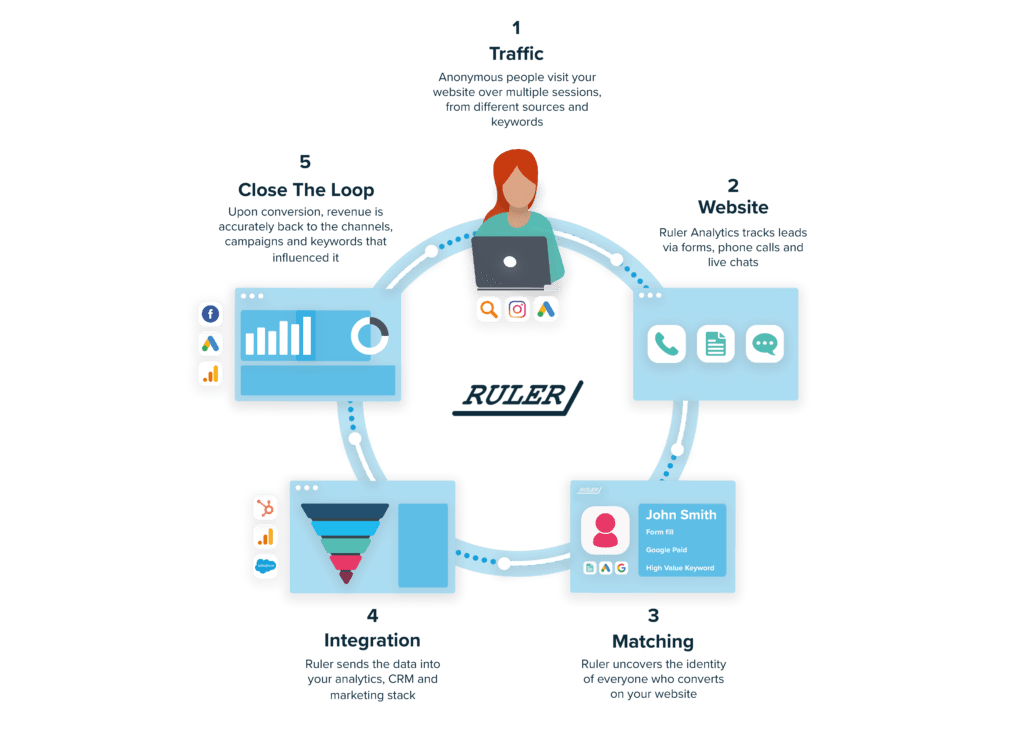Struggling to measure your digital marketing ROI? You’re not alone. This guide will walk you through marketing ROI, the key marketing metrics you need to track and how to best track them.
Digital marketing ROI is a value that is increasingly difficult to measure.
With marketers chasing different industries, customers and using different channels, it can be hard to create one cohesive measurement of digital marketing ROI.
Some marketers might chase viral content on social media, while others look for deep engagement in email, so how do you pinpoint what to measure in marketing?
While it’s easy to get fixated on industry buzzword metrics, these don’t give you a clear indication of how your money, time and tools are working to drive you new sales.
To better understand the moving parts of your marketing strategy, you need to be looking at your marketing ROI as a whole.
But where do you even begin? With new channels, platforms and advertising opportunities, it’s hard to link these all into one report.
This blog will walk you through:
So, let’s get stuck in!
Digital marketing ROI, or return on investment, is the measure of profit or loss generated by your digital marketing campaigns. It looks at the amount of revenue generated compared to the amount of money invested.
Related: What is marketing ROI and how to calculate it
If you have a positive return on investment, then your campaigns are bringing in more money than you are spending on them. And that’s where you want to be!
Demonstrating digital marketing ROI across your channels, campaigns and ads is essential because, without it, you’re marketing blind.
According to our recent survey, only 23% of marketers are confident they’re tracking the right KPIs.
While 60% of marketers said they are confident they prove marketing ROI, you’ve got to ask yourself: if you’re not sure you’re tracking the right KPIs, how do you know you’re proving ROI?
By understanding what’s working and what isn’t you can tweak your strategy and your planning to help grow high-quality leads and ultimately grow revenue.
Knowing your ROI not only means you can optimise your current budget, but it also means you can make quick decisions on where to allocate your budget in the future.
Return on investment compares the profit created to how much was invested. Ideally, you want as high an ROI as possible as this means you’re making more for your money.
The basic ROI calculation is:
ROI = (Net profit/Total cost) *100
This ROI measurement doesn’t mean much though if you have inaccurate data, or if you’re measuring the wrong metrics.
Before you calculate your marketing ROI, consider the following:
If you work in eCommerce then it’s easy to track your revenue and so easy to track marketing ROI.
But what if you rely on offline sales? Or if you tend to see long and complex customer journeys which makes it hard to track leads, sales and revenue?
We know how tricky it can be to track new leads, work out their source and then track their full customer journey and attribute closed revenue back to your marketing.
Marketing attribution tools take away the data headache so you can automatically attribute your revenue back to the marketing channels, campaigns and ads that influenced them. In fact, we have a blog on how attribution tools can help you track the true value of your marketing impact.
Even better, tools like ours will calculate your ROI for you. So, you’ll be able to automatically view your ROI by channel, campaign, ad and even keyword.
Related: How Ruler attributes revenue to your marketing touchpoints
While you want to measure revenue when it comes to marketing ROI, you also want to track your vanity metrics too.
Website traffic doesn’t result in sales, but it does give a good indication of how your channels are performing. Setting KPIs that highlight the potential of your marketing is also important to include when it comes to measuring your digital marketing ROI.
Honestly, it depends. ROI depends on your industry, your market and your marketing!
But, we are here to help. We analysed 14 key industries to better understand how conversion rates differ industry to industry. You can view the overall conversion benchmark report here. Or, find a specific industry report in our resources section.
The first step to properly measuring your digital marketing ROI is choosing the right metrics.
This is often the first hurdle marketers fall down at.
Because realistically, some metrics are just easier to track than others.
So we opt for what’s easy and wind up tracking vanity metrics that mean very little.
To help you out, we’ve listed the 6 metrics you need to measure to understand your marketing ROI, plus, tips on how to effectively track them.
We’ll be tracking:
So let’s get stuck in!
Whether it’s phone calls, form submissions, content downloads or newsletter subscriptions, understanding your marketing’s impact on your conversions is essential.
Setting up goals in Google Analytics is pretty simple and will give you great coverage on how your marketing is working to generate leads.
Related: Setting up goals and assigning values in Google Analytics
Once your goals are set up, you can view your conversion data across a multitude of reports.
You can see it by marketing channel or by landing page meaning you can begin to understand which pages and channels are working best for you.
Make sure you’re tracking these numbers month on month for an idea of how many enquiries your sales team are fielding each month, quarter and year.
⚡️ Pro Tip
Go beyond conversion tracking by linking your revenue to your Google Analytics. By getting a full, closed-loop view of your marketing, you can understand which channels, campaigns and even keywords are driving real results.
Now you know how many conversions you’re getting, you’ll want to know how much they’re costing. If you’re using a budget for pay-per-click to drive lead generation, then understanding your cost per lead is essential to learning whether your adverts are working.
Related: Complete guide to cost per lead
If you’re spending £100 on paid adverts to generate 4 leads, then that’s a cost per lead of £25.
Of course, you want to be generating high-quality leads for the lowest possible cost.

If you find your cost per lead is higher than its potential value, then you need to evaluate your marketing efforts. With marketing attribution, you can assign the actual revenue to your leads when they close. You can also track offline conversions which means your CPL is going to drop down too, as you’re getting a true visualisation of your marketing’s impact on your revenue generation.
Related: What about revenue per click?
This means you can get a true cost per lead, and a view of the full picture. If you want to learn more about marketing attribution metrics, skip ahead.
Ok, so you now know how many leads you’re getting, and at what cost. But how many of those leads are converting into sales?
Chances are this information will be within your CRM such as Salesforce, or you may have to request it from your sales team. Once you have, it works out like this:
Divide the number of successful sales by the number of leads and multiply the outcome by 100. The result is your closing ratio expressed as a percent. If, for example, you had 50 sales leads and 10 closed sales, the ratio is 10 divided by 50 multiplied by 100, which equals 20 percent.
Understanding this metric allows you to quantify the performance of your marketing campaigns from a revenue generation perspective.
⚡️ Pro Tip
Remove the manual work and use marketing attribution to do the hard work for you. Here’s how you can track where leads come from using Ruler. Measure clicks, leads, sales and revenue all in one easy to use dashboard.
👉 Book a demo to see it in action.
Lifetime value is an effective metric to measure to understand your digital marketing ROI from a holistic perspective. By measuring customer lifetime value (or CLTV) in relation to cost of customer acquisition (CAC), companies can measure how long it takes to recoup the investment required to earn a new customer.
Related: Understand the LTV:CAC ratio
CLTV is an ever-changing metric to understand how much revenue you can expect one customer to generate over the course of the relationship. The longer a customer is retained, the greater their value becomes. As such, managing churn needs to be a part of your sales and marketing process.
To calculate CLTV, you need to know your average purchase value, and then multiply that number by the average frequency rate to determine your customer value. Then, once you have your average customer lifespan, simply multiply that by your customer value.
Sounds complicated? HubSpot has a great page on how to measure each aspect.

Your cost per acquisition tells you how much it costs on average to acquire a new customer.
To calculate cost per acquisition, divide your total marketing costs by the number of sales generated. Understanding your CPA gives you better insight into your digital marketing ROI.
If you’re spending more to acquire a customer than a customer actually brings in, then you need to reassess your marketing strategy and campaigns.
Related: Easy ways to reduce your cost per acquisition cost

Ok, so if you’re an eCommerce marketer, then attributing revenue to your marketing campaigns can be done directly within Google Analytics so you’ll have no need for plenty of the metrics listed above.
By measuring with revenue, you can quickly determine which marketing channels and campaigns are working to drive more sales.
But what if you generate leads that are passed to sales?
Or, if you tend to see long sales cycles so you can’t get visibility of how users interact with different channels before converting?
Marketing attribution is an easy solution to these problems.
Related: Complete guide to marketing attribution
Tools like Ruler Analytics will track each and every lead (whether that’s by phone call, form submission or live chat), and every touchpoint too.

It allows you to view which marketing channels and campaigns are driving new leads. Even better, it continues to track leads until they close.
So, when revenue is added to a lead in your CRM, Ruler will scrape that data and fire it to your marketing channels and campaigns,
You’ll be able to see, without any doubt, what parts of your marketing are not only driving leads but driving leads that convert. And, how much they convert into.
Do you want to track revenue but find it hard?
You’re not alone. It’s hard to get visibility of your leads when you’re a marketer.
Your apps don’t speak to one another meaning leads come from your website and go to your CRM. But there, you lose visibility on their source. You also can’t see their full customer journey.
Related: Vanity metrics vs actionable metrics
And so when the revenue closes for a lead, you can’t match it back to the marketing source. This means you continue basing your marketing decisions on things like ‘likes’, or clicks or impressions.
By using the metrics listed above, you can get the right data and start making data-driven decisions.
Do you regularly use offline conversions in your marketing and not sure how to track them? Download our guide to learn the best way to track every lead no matter where they come from.